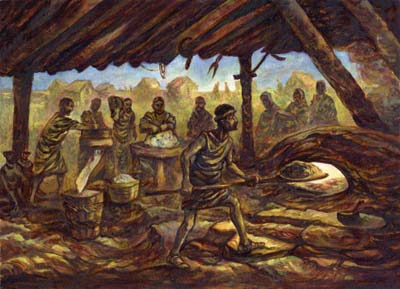Objects of stone
Two types of objects are most numerous among those made of stone. Although very frequent in the form of sherds, whole millstones are rarely found. Vulcanic rock was most frequently used for these, but the millstones of the 1st century differ from the late Classical ones in shape. The older ones photo 76 are of a smaller dimension and with thicker stones with wide funnel-like openings for pouring grain, while the late Classical ones photo 129 are thinner, with a larger dimension, usually with two smaller circular openings for pouring grain on the uppermost stone. Both belong to the type of manual millstones that have a space for implanting wooden handles at the side. The use of millstones from the late Classical period most probably continued later on as well, during the Middle Ages, although no whole ones from that period have as yet been found..
Picture 2/13: Grinding of grain with millstone and making of bread.Whetstones of photo 127, 75, 96, 171, of various shapes and sizes were made of stone of various structures, hardness and color. They were found in structures from all periods and according to the characteristics of the stone they were made of they were used for the sharpening of various types of blades, from small kitchen knives to weapons.
Small pieces of flint were found in several cases photo 77. It is possible that they originate from the stiking of the flint used to light fires, but there is also the possibility that they came from prehistoric structures and layers found in the vicinity, in which case they would be fragments of stone tools (blades).
Objects were made from several rounded pieces of stone that, judging by their circular openings, were most probably used as amulets photo 52, 125.

